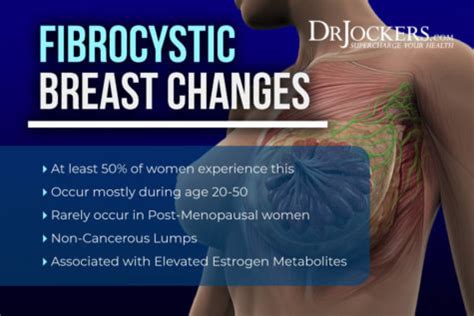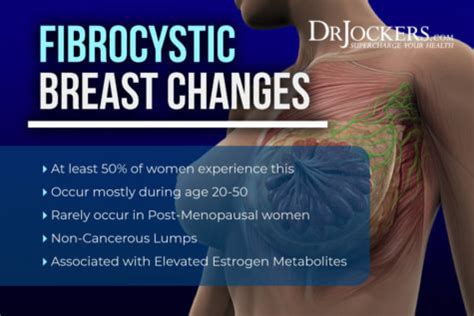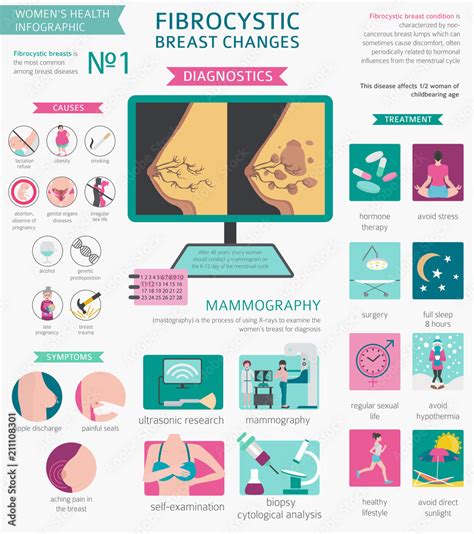Intro
Discover 6 fibrocystic symptoms, including breast tenderness, lumpiness, and cyclic pain, to identify and manage fibrocystic breast changes, a common condition affecting womens breast health and comfort.
Fibrocystic breast disease, also known as fibrocystic breast changes, is a condition characterized by the development of lumps or cysts in the breast tissue. This condition is extremely common, affecting up to 60% of women at some point in their lives. While it is not typically a cause for concern, understanding the symptoms and how to manage them can significantly improve the quality of life for those affected. The symptoms of fibrocystic breast disease can vary widely among individuals, but there are several key indicators that are commonly experienced.
The breast is composed of glandular, fatty, and fibrous tissue, and the balance of these components can influence the development of fibrocystic changes. Hormonal fluctuations, particularly the rise and fall of estrogen and progesterone levels throughout the menstrual cycle, play a significant role in the development of these symptoms. As the body prepares for a potential pregnancy each month, the breasts undergo changes that can lead to the formation of cysts and lumps. Understanding these hormonal influences can help in managing the condition.
For many women, the symptoms of fibrocystic breast disease are mild and may not require medical intervention. However, for some, the discomfort and anxiety caused by these symptoms can be significant. Recognizing the symptoms and understanding their causes can be the first step in finding relief. Whether through lifestyle changes, dietary adjustments, or medical treatments, there are various ways to manage fibrocystic breast symptoms and reduce their impact on daily life.
Fibrocystic Breast Disease Overview

Causes and Risk Factors
The exact cause of fibrocystic breast disease is not fully understood, but several factors are believed to contribute to its development. Hormonal changes, particularly the fluctuations of estrogen and progesterone, are thought to play a key role. Other potential risk factors include a family history of the condition, dietary factors, and the use of certain medications.Symptoms of Fibrocystic Breast Disease

Managing Symptoms
Managing the symptoms of fibrocystic breast disease often involves a combination of lifestyle adjustments and medical treatments. Over-the-counter pain relievers can help alleviate discomfort, while warm compresses or a well-fitting bra can provide additional relief. In some cases, hormonal treatments or surgery may be recommended to manage more severe symptoms.Lifestyle Changes for Symptom Relief

Dietary Considerations
Dietary factors can also play a role in managing fibrocystic breast symptoms. Increasing the intake of omega-3 fatty acids, which are found in foods such as salmon and flaxseeds, may help reduce inflammation. Additionally, ensuring adequate vitamin and mineral intake, particularly vitamin D and iodine, can support overall breast health.Medical Treatments for Fibrocystic Breast Disease

Alternative Therapies
Alternative therapies, such as acupuncture and herbal supplements, are sometimes used to manage the symptoms of fibrocystic breast disease. However, it's crucial to discuss these options with a healthcare provider, as their effectiveness and safety can vary.Conclusion and Next Steps

We invite you to share your experiences or ask questions about fibrocystic breast disease in the comments below. Your insights can help others better understand and manage their symptoms. Additionally, consider sharing this article with someone who might benefit from the information, helping to spread awareness and support for those affected by this common condition.
What are the primary symptoms of fibrocystic breast disease?
+The primary symptoms include breast tenderness or pain, lumps or cysts, changes in breast texture, nipple discharge, and breast swelling. These symptoms can vary in severity and are often influenced by hormonal fluctuations.
How is fibrocystic breast disease diagnosed?
+Diagnosis typically involves a physical examination by a healthcare provider, who will check for lumps or abnormalities in the breast tissue. Imaging tests such as mammograms or ultrasounds may also be used to confirm the presence of cysts or other changes.
Can fibrocystic breast disease increase the risk of breast cancer?
+While fibrocystic breast disease itself does not increase the risk of breast cancer, having a family history of breast cancer or other specific types of breast conditions can elevate this risk. Regular screenings and check-ups with a healthcare provider are essential for early detection and prevention.
